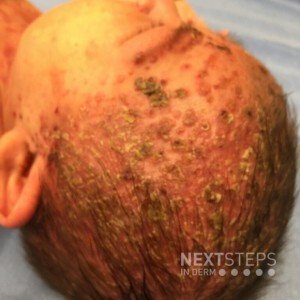
The correct answer is E. Obtain skin biopsy.
In infants, Langerhans cell histiocytosis (LCH) can mimic severe seborrheic dermatitis. A skin biopsy should be performed to make the diagnosis. This question tests the examinee’s ability to recognize LCH presenting with coalescing erythematous papules with secondary crusting and erosion on an infant’s scalp, and know the correct next step in management. A skin biopsy (choice 5) is required to make the diagnosis of LCH. Prescribing a strong topical steroid solution (choice 1) is generally inappropriate in infants and will not assist in making the diagnosis imminently needed in this scenario. Although secondary impetiginization may be present, obtaining a bacterial culture (choice 2) is not the best answer because it will delay the diagnosis of LCH, a potentially life-threatening condition. The favus form of dermatophyte hair infection can produce large yellow crusts on the scalp, but would not be expected to demonstrate discrete erythematous papules; therefore, fungal culture (choice 3) is not the best answer. A complete blood count (choice 4) is obtained as part of the workup for LCH, but is of lower priority than skin biopsy to make the initial diagnosis.
References: Tran G, Huynh TN, Paller AS. Langerhans cell histiocytosis: A neoplastic disorder driven by Ras-ERK pathway mutations. J Am Acad Dermatol. 2018 Mar;78(3):579-590.
